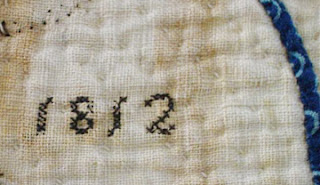Ship from a quilt dated 1847 in the collection of the
Grand Rapids Public Museum
See more at Lisa's Stray Threads blog:
On a single day in May, 1815, fifty-three cargo ships arrived
in U.S. ports, carrying tons of pottery, iron, paints, drygoods, tea and
pianofortes, according to Justin Winsor's 1883 Memorial History of Boston.
Boston Harbor 1833
William J. Bennett
By December American manufacturers, particularly textile
manufacturers, begged Congress for relief. During the War import taxes doubled, but the extra duty was to expire in 1816. Congress extended taxes on goods such
as iron and sugar, and increased duties on cotton and woolen goods.
Low-grade cotton
cloth from India was a particular target. Indians could produce cloth so
cheaply that no American manufacturer could hope to compete even without the
international shipping costs. Cheap India goods were eventually taxed at 100%
of their value, which put an end to the venerable U.S.- India trade.
While India sold goods at cost, English merchants were so
desperate to sell the tons of fabric stored in their warehouses during the Napoleonic
Wars they were willing to sell for less than the manufacturing cost. Dumping,
defined as selling goods for lower than what it cost to produce them, became a
political issue in the U.S.
We tend to remember Clay as the Great Compromiser
but he ran for President at the Protector of Home Industries
Among the protectionists were Secretary of the Treasury
Alexander Dallas, for whom the 1816 tariff was named, and Representative Henry
Clay who had made his reputation by starting the war as a War Hawk, ending the
war on the Ghent peace commission and maintaining the hostilities as an
advocate of Home Industries and tariffs.
New Hampshire's Amoskeag Mill, built 1847
The expected consequence was a welcome increase in American
textile manufacturing. The United States, a minor player, became an industrial
contender by mid-century.
Free Trade vs. Protection of Home Industries
The discussion continues today.
Unexpected consequences were also significant. Tariffs favoring
infant Northern industries penalized Southern consumers, trading raw cotton for
finished goods. The Dallas Tariffs increased sectionalism as Southern politicians
promised to end import taxes and Northern politicians advocated maintaining
them. The North and the South began to see themselves as very different cultures with
different goals.
Another consequence was a decline in value for textiles and
other goods. In 1832 Congress collected information on the topic with
respondents reporting
"In printed goods, a piece of print, (used for ladies'
dresses,) costing then 36s[shillings]. a piece, can now be had for 18s. and
22s. In 1816, a piece of common blue and white calico... 32s. sterling per
piece; the same can now be had for 12s. to 15s..."
"The prices of all the coarse fabric of cotton, such as
shirtings, sheetings, checks, tickings, stuffs for men's wear, such as
granderells, unions &c; and also of calicoes, both gray and printed; it is
universally known have declined...from 25 to 75 per cent. [Gray calicoes are
cotton cloth yet unprinted]
Jane Valentine's quilt dated 1825-1830
Smithsonian Institution
These American quilts reflect the wide range of cotton prints
available after the War of 1812
A drop in price was good news for shoppers--- increasingly cheaper cottons
opened up a whole world of consumerism for people on the lower rungs of the
economic ladder and cheaper cottons probably increased an interest in
patchwork.
Sarah Johnson's quilt dated 1826
Shelburne Museum
Amelia Lauck's quilt dated 1822
But the effects on manufacturing and trade continued a long
financial depression that had begun when France and England went to war in the early 19th
century and drew the United States into the fight. It took decades to recover from the Napoleonic Wars.
I like to blame it all on Boney---years of fabric deprivation.
A Postscript on Henry Clay as the Protector of Home Industries
Thirty years after the War of 1812 Clay received a quilt as a gift, made by Elizabeth Schultz of Pennsylvania, "cloth, thread and every thing of home production." That quilt is in the collection of Clay's Kentucky home Ashland and now on loan to the American Textile History Museum's show
Home Front and Battle Field.
Detail of the center of quilt by Elizabeth Schultz
One might understand that Schultz produced the fabrics by homespinning and weaving but what was meant was that these were factory cottons produced in the United States. The quilt was accompanied by a flowery tribute to Schultz's age (76), to Clay and to "the
Needle---the NEEDLE, that implement and emblem of
industry the source of all prosperity, of which throughout your whole life, you have been recognized and unrivalled advocate, protector and champion."
See a summary of this correspondence in a preview of
The Papers of Henry Clay, Volume 10
http://books.google.com/books?id=bZQQETnM6_gC&pg=PA338&lpg=PA338&dq=henry+clay+quilt&source=bl&ots=I0ODcgUgLo&sig=rxGHOoHjO9OiZm8M3LAifCZylVo&hl=en&sa=X&ei=4bJ5UJPPI5K68wSJu4DwBA&ved=0CFwQ6AEwDQ#v=onepage&q=henry%20clay%20quilt&f=false



































































